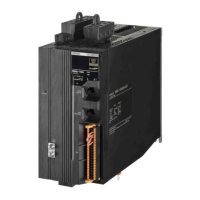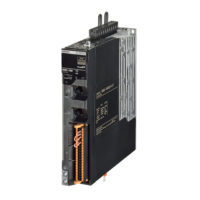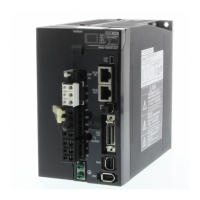
Do you have a question about the Omron R88D-1SN20F-ECT and is the answer not in the manual?
| Model | R88D-1SN20F-ECT |
|---|---|
| Applicable Motor Capacity | 2.0 kW |
| Communication | EtherCAT |
| Ambient Operating Temperature | 0 to 55 °C |
| Type | AC Servo Drive |
| Rated Supply Voltage | 200-240 VAC |
| Input Voltage | 200 to 240 VAC |
| Protection Functions | Overvoltage, Undervoltage, Overcurrent, Overload, Overheat |
| Vibration Resistance | 4.9 m/s² |
| Shock Resistance | 98 m/s² |
This section explains the features of the Servo Drive and name of each part.
This section explains the models of Servo Drives, Servomotors, Decelerators, and peripheral devices, and provides the external dimensions and mounting dimensions.
This section provides the general specifications, characteristics, connector specifications, and I/O circuits of the Servo Drives as well as the general specifications, characteristics, encoder specifications of the Servomotors and other peripheral devices.
This section explains the conditions for installing Servo Drives, Servomotors, and Decelerators, the wiring methods including wiring conforming to EMC Directives, the regenerative energy calculation methods, as well as the performance of External Regeneration Resistors.
This section explains EtherCAT communications under the assumption that the Servo Drive is connected to a Machine Automation Controller NJ/NX-series CPU Unit or Position Control Unit (Model: CJ1W-NC8).
This function stops the motor based on a signal from a safety controller. This section provides the outline of the function and examples of operation and connection.
This section explains the details on each servo parameter, including the set values, settings, and the display.
This section provides the operational procedure and explains how to operate in each mode.
This section explains the functions, setting methods, and items to note regarding adjustments.
This section explains the items to check when problems occur, and troubleshooting by the use of error displays or operation state.
Qualified engineers must develop safety systems and install safety products correctly. Verify through testing.
Qualified engineers must develop your safety-related system and install safety products in devices and equipment.
Provides warnings and precautions for installing, wiring, and maintaining the Servo Drive, Servomotor, and peripheral equipment.
Wire the cables correctly and securely. Runaway motor, injury, or failure may result.
Wire the cables correctly and securely. Runaway motor, injury, or failure may result.
Install an immediate stop device externally to the machine so that the operation can be stopped and the power supply is cut off immediately.
Before operating the Servo Drive in an actual environment, check if it operates correctly based on the newly set parameters.
The 1S-series Servo Drives have the following features: Optimal Functionality and Operability by Standardizing Specifications, Data Transmission Using EtherCAT Communications, EtherCAT Communications Cycle of 125 µs, High Equipment Utilization Efficiency with 400-V Models.
EtherCAT is an open high-speed industrial network system that conforms to Ethernet (IEEE 802.3). Each node achieves a short communications cycle time by transmitting Ethernet frames at high speed.
The system configuration for a 1S-series Servo Drive with Built-in EtherCAT Communications is shown below.
The block diagram of a 1S-series Servo Drive with Built-in EtherCAT Communications is shown below.
This section explains the procedures to operate a system that incorporates 1S-series Servo Drives.
This section shows the Servo system configuration that consists of Controllers, Servo Drives, Servomotors, Decelerators, and other devices.
This section describes how to read and understand the model numbers of Servo Drives, Servomotors, and Decelerators.
This section lists the models of Servo Drives, Servomotors, Decelerators, cables, connectors, peripheral devices, etc. in the tables.
This section provides the external dimensions and mounting dimensions of Servo Drives, Servomotors, Decelerators, and peripheral devices.
This section provides the general specifications, characteristics, connector specifications, and I/O circuits of the Servo Drives as well as the general specifications, characteristics, encoder specifications of the Servomotors and other peripheral devices.
The specifications of the Servo Drives are shown below.
The characteristics of the Servo Drives are shown below.
The specifications of EtherCAT communications are shown below.
When you wire the main circuit, use proper wire sizes, grounding systems, and noise resistance.
The specifications of the control I/O connector are shown below.
The specifications of the safety I/O are shown below.
The specifications of the brake interlock connector are shown below.
The overload protection function (electronic thermal) is built into the Servo Drive to protect the Servo Drive and Servomotor from overloading.
This section gives the examples of connection with peripheral equipment and wiring such as connection of the main circuit and Servomotor.
1S-series Servo Drives conform to the EMC Directives (EN 61800-3) under the wiring conditions described in this section.
The Safe Torque OFF (STO) function is used to cut off the motor current and stop the motor through the input signals from a safety controller.
This section explains how to use the STO function via the safety input signals.
This section explains how to use the STO function via EtherCAT communications.
These objects are used for the error and warning setting.
Perform installation and wiring correctly, and turn ON the power supply to check the operation of the individual Servomotor and Servo Drive.
This section explains the procedure that you perform to prepare the system for operation after installation and wiring of the Servomotor and Servo Drive are completed.
When you finished installation, wiring, and switch settings, and confirmed that the status was normal after turning ON the power supply, perform test run.
If any problems should occur, take the following actions.
This function outputs a warning signal to enable you to check a state such as an overload before an error occurs.
If the Servo Drive detects an abnormality, it outputs an error (/ERR), turns OFF the power drive circuit, and displays the error number (main and sub) on the front panel.
If an error occurs in the Servo Drive or operation, identify the cause of the error and take appropriate measures as shown below.
This section lists and describes the error event codes that you can see in Sysmac Studio.











